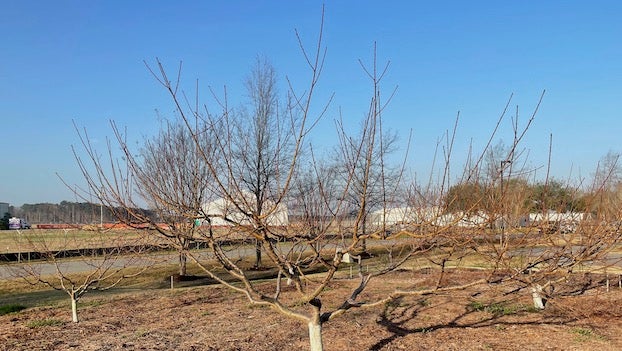When can I prune my fruit trees?
Published 10:55 am Friday, February 24, 2023
|
Getting your Trinity Audio player ready...
|
Do you have fruit production in your backyard? This can be a very rewarding and very frustrating part of horticulture production. Fruit trees are not for the faint of heart. Most folks think that they can just stick a tree in the ground and grow fruit but this is far from the case, especially here in Eastern NC.
In a nutshell, soil testing, site prep, variety/rootstock selection and planting are all important to getting a great start for your production endeavor. The next steps are training and pruning.
Sounds like the same thing, right? Nope. Training takes place the first five years after the tree is planted. We train trees when they are young so that they will maintain their shape and structure when they grow older to bear good fruit. Training involves making very selective cuts on the tree to encourage branching in specific areas, crotch angles that will bear heavy loads, and light distribution to the areas where the fruit is growing. There are two types of training, central leader and open systems. A central leader system is trained much like a Christmas tree shape. This is for tree fruit that bears fruit on the branch ends or terminals such as apples and pears. An open center system has no central leader, it is cut out very early to open the center of the tree. This is for fruit trees that bear fruit all along the branches such as peaches and nectarines.
Training also involves encouraging branching or scaffolding in certain areas of the tree. In a central leader system, we want to have whorls of four scaffolds every two feet moving up the main trunk. This can be done by cutting the central leader 6”-8” above where branching should occur. This produces multiple stems; several will grow directly up and several will grow laterally. Training selects one of the straight up branches to continue the central leader. Next, four of the lateral branches are selected for the scaffold branches to bear fruit.
An open system is much different in that the scaffold branches are selected the first year. The central leader is cut out completely and the center is maintained open throughout the life of the tree through pruning. If there aren’t good scaffold branches present on the tree in the first year, we can use the same process as the central leader system to make the branches we want to grow. The central leader will then be cut out the following year.
So where do we begin with our branching? In an orchard situation it is typically 18”-24”. However, in a residential setting, you may want to have it high enough to drive your mower under it.
So, what is pruning? This is the time of year that calls begin to come in regarding fruit tree pruning. These vary from how to prune to when to prune. First, let’s just say that if you’re growing fruit, you need to prune every year to encourage fruit production. I know some of you reading this are saying, “I’ve never pruned and I always have good fruit.” That can be the case but for very few folks, I promise, your time is coming.
Pruning is done on an annual basis to assist in fruit production, light interception, and light distribution. Fruit production requires light. We are really harvesting light to produce good fruit. Fruit comes from a flower; a leaf bud requires 30% direct sunlight to change from a leaf bud to a flower bud. This all occurs during the previous season. This year’s sunlight is producing next year’s fruit buds. This is another layer to pruning, we don’t want to prune off our flower buds so we need to know where the tree will bear fruit. On apples and pears, this will be on spurs and terminals. Peaches will bear fruit all along the scaffold branches. So, we want light interception by the tree and we want light distribution to the areas of the tree that are growing fruit.
When is the best time to prune trees though? When dealing with apples and pears, mid-January to early February is good. Peaches are a little later ranging from early February to early March. This year is looking like they will be in bloom a little earlier so pruning may need to be earlier as well. If you haven’t gotten your trees cleaned up yet this year, you had better get out there.
If you would like more information on growing tree fruit for home production, please visit https://horticulture.ces.ncsu.edu/comprehensive-resources-for-fruit-trees/. I will be holding a class on March 10 that will provide some hands-on experience with peaches at the Beaufort County Extension Center. This is a part of the “What you need TO KNOW so you can GROW” series that will be taught every Friday from 9:00-11:00 throughout March. Please call the office for more information.
If you are having trouble with growing in your home landscape, call the Extension office at (252)946-0111 or email me at gene_fox@ncsu.edu. I will be holding a pesticide credit and Landscape Contractor’s license credit class at the Vernon James Center on Monday 2/27 from 9:00-12:00. There is no sign-up for this.
Save the date for April 14th at 9:00 when the Extension Master GardnerSM Volunteers will be having their annual vegetable transplant sale. Until then, Happy Gardening!




